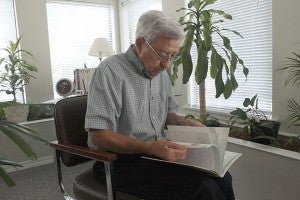Local scientist to be featured on National Geographic channel
Published 4:10 pm Saturday, June 21, 2014

PLANT TREATMENT: Dr. Bill Wolverton looks through his book, entitled “Plants, Why You Can’t Live Without Them,” in a special room he built on his home that uses plants to clean the air.
Photo by Jeremy Pittari
Local scientist Dr. Bill Wolverton will be featured in a documentary that tells about the power of plants.
Wolverton’s part of the hour-long program will focus on how plants can remove pollutants from the air and water.
In fact, Picayune residents have benefited from his work since 1991 when the old sewage lagoon was installed to treat the city’s wastewater. An earlier design of that lagoon was built 40 years ago at the Mississippi Test Facility, now known as John C. Stennis Space Center. The Stennis treatment facility is still operating to this day, Wolverton said. Picayune’s has since been semi-retired; it now only treats excess waste and storm water.
Bill and his wife moved to the area back in 1971 when he took a job at the test facility to conduct environmental testing to detect whether operations at the site were polluting the environment. His testing showed pollutants were being produced, so he devised a way to counteract it, leading to the plant based water treatment facility. That facility, installed in 1974, uses aquatic plants to remove and process waste in the water.
In the documentary he demonstrates how the Stennis treatment facility works. By using Water Hyacinths, the wastewater is treated successfully. So successfully, that the only maintenance required is to annually remove the large amounts of the plants that grow in the lagoon.
Wolverton also created an enclosed structure where plants were used to clean the air of pollutants expelled by the synthetic materials of which the building was constructed. Before the plants were installed in the “biohome” the pollution in the structure caused people to suffer from burning eyes and sore throats. After the plants were placed inside, within a couple of weeks the air was clean enough to enter without irritation.
He developed this technique as a viable option to not only clean the air for habitats established on the moon and Mars, but also provide oxygen and food.
Using the plants on the International Space Station poses challenges due to the lack of gravity. Wolverton said the microgravity in low Earth orbit causes plants to grow erratically. They need gravity to grow in the manner they would on Earth, and the moon and Mars provide enough of that gravity.
Wolverton’s studies showed that plants remove the pollutants by breaking them down with the assistance of microbes that grow on their roots, whether on Earth or in space applications.
He also developed potting technology that removes the possibility of mold development by removing soil from the equation. Instead of soil, his method uses expanded clay, which is porous and holds water, combined with activated carbon. Wolverton said the carbon absorbs the pollutants, which the microbes break down so the plant can use them as food.
In exchange, the plant expels fresh oxygen.
Wolverton also developed a similar system in his home that processed the wastewater produced in his home. By using an irrigation system and plants he was able to expel water fresh enough to pass through a fish tank before being discharged to a nearby pond. He has since disassembled the system in his home to make it real estate ready.
While not every plant is able to break down all of the chemicals in human waste, Wolverton said it is possible to use the effluent to grow food, but only by utilizing some special procedures.
“If we’re going to continue to live on this planet and reproduce at the rate we have, we’re going to have to convert our human waste,” Wolverton said.
“Power of Plants” will air on the National Geographic Channel Wednesday at 8 a.m.




